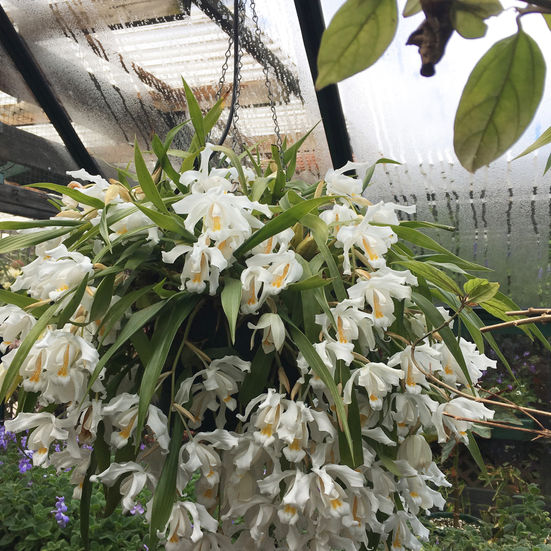
Photo: Cascading Cymbidium grown in Autopot® Hanging Baskets
Growing orchids made easy in Autopot® Systems
For most people, growing orchids successfully is not easy. The main problem is the extreme difficulty in telling exactly when an orchid requires watering. Orchids, unlike the majority of other pot plants, don't show wilting symptoms even when they are desperately short of water. There is no way of knowing exactly when an orchid is suffering from water stress. Often, it is too late by the time water is given to the plant as the orchid would have already suffered some setback which, though not immediately apparent, will certainly reduce the production of blooms. Taking a Petunia for comparison, it starts to wilt the moment it experiences shortage of water, so it is pretty obvious to anyone that the plant should be watered right away so it can recover.
Orchid growing couldn't be easier with AAutopot® Systems. It's as simple as planting your orchids in to the Autopot® planters, and then either connecting to the Autopot® Smart Pump Set, filling up a gravity fed reservoir, or filling the outer reservoir in the case of the Twin-Wall models. The day to day watering and feeding of the orchids will be taken care of by Autopot® Systems, not just for a week, or a month, but for years. We have specimens that have been growing and flowering extremely well every year in Autopot® Systems since 1991.
Why do orchids grow so well in Autopot® Systems?
The answer lies with the fact that Autopot® Systems are a "plant driven" system. The Autopot® plant driven concept will work on all plants, including orchids, all varieties of orchids. We have grown orchids in low humidity (40%) even though they came from high humidity areas. The photo gallery below shows a range of orchid varieties growing happily in various Autopot® modules.
Our methods of growing orchids differ from conventional methods in several ways;
1. We do not recommend the use of sphagnum moss.
Sphagnum moss will decay over time. It lasts perhaps for 2 to 3 years and thereafter ceases to serve its purpose (mainly holding moisture in the orchid mix). That's fine for conventional orchid growing methods since it's general practice to repot (and divide) the orchids every 2 to 4 years. However, with Autopot® Systems we rarely need to repot or divide our orchids for the life of the plant. For that reason we do not use sphagnum moss as it will break down in a couple of years. We use granulated rockwool instead as part of the growing medium for the orchids. Rockwool, being inorganic, will never break down and hence will retain its moisture absorbing properties indefinitely.
2. We do not need to repot our orchids even when they are pot bound.
One might argue that when an orchid becomes pot bound it will not grow properly unless it is repotted and divided. But this is not the case with plants grown in Autopot® Systems. Even when orchid plants get pot bound, it does not seem to bother the plants. They continue to grow healthily and flower very well every year. We feel that the pot bound factor is not an issue as long as we can keep up with the moisture and nutrient needs of the plants, with the Autopot® Systems able to do just that.
3. We expose our orchids to more sunlight.
We expose our orchids to more sunlight than conventionally recommended and we've found that our plants produce more and longer spikes, larger flowers and much stronger colours. Exposing plants to more sunlight makes it more difficult to keep up with their moisture requirements when watered by conventional techniques. Hence, such plants are more likely to suffer from underwatering on days when they require a lot more water than usual e.g. during hot and windy days. With Autopot® Systems, the watering and feeding is controlled by the plants, keeping up with their moisture and feed requirements.
4. We use standard Autopot® hydroponic plant food.
Hydroponic fertilisers are a full spectrum complete nutrient formulation that has to work even in sterile mediums whereas regular orchid fertilsers are not required to have the same range of nutrients. We found that our orchid plants thrived on our standard hydroponic fertilisers and we can understand why - it's because orchid growing is actually a form of hydroponics - for example epiphytic orchids occur naturally on tree tops where they survive purely on foliage debris.
Below are a display of a wide range of orchid varieties growing happily in various Autopot® Systems.
View Cymbidium orchids in Autopot® Hanging Baskets bearing 30 spikes of 30 to 50 flowers per spike. An incredible number of flowers from a single 10" Hanging Basket!!



















